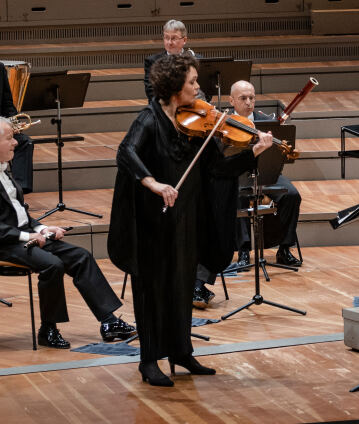François-Xavier Roth and Tabea Zimmermann

Paul Hindemith is a composer close to Tabea Zimmermann’s heart. It thus comes as no surprise that as Artist in Residence she will perform his viola concerto Der Schwanendreher. The work owes its peculiar title to a German folk song whose melody forms the basis of the third movement. Béla Bartók was also inspired by folk music in his Divertimento. His work is based on Romanian and Hungarian dance music. The programme, conducted by François-Xavier Roth, opens with Carl Philipp Emanuel Bach’s First Symphony, which already clearly looks ahead to the First Viennese School.
When people spoke of the “great Bach” in the 18th century, they were not referring to Johann Sebastian, but to his son Carl Philipp Emanuel, whose fame reached throughout Europe. His compositional originality is particularly evident in the stark contrasts, harmonic boldness and surprising melodic progressions. This is also the case in his last four symphonies, composed in 1775/76, in which he added bright wind colours to the string orchestra – in the spirit of the expressiveness of the Sturm und Drang period.
“It seems to me just as impossible to run up against the apparatus that has been set up to defame me as it is unworthy of me to go to the same level in defence of my work. I rely on the power that is the epitome of my life: music,” wrote Paul Hindemith in 1934. Immediately beforehand, Joseph Goebbels had publicly branded him an “atonal noisemaker”; the violist and composer was at risk of being banned from his profession in Germany. Outwardly, together with high-profile supporters such as Wilhelm Furtwängler, he defied the hostility – in secret, he planned his escape, which was heralded by his 1935 viola concerto Der Schwanendreher. From old German folk tunes which Hindemith as a “minstrel” – as he explains in the preface – “preludes and improvises on”, the solo viola plays significant verses in the course of the piece: “Glück liegt in allen Gassen” (1st movement) – “Nicht länger ich’s ertrag” – “Hab gar ein’ traurig’ Tag” (2nd movement). Hindemith fled to Switzerland in the summer of 1938.
When Béla Bartók visited the conductor and entrepreneur Paul Sacher in the Swiss mountains in 1939 to compose a divertimento for string orchestra on his behalf, he wrote he felt “like a musician from an old world invited by his patron”. The outer movements of the three-part work also open up an older, bygone world. Dancelike and in part audibly inspired by Bartók’s folk music studies, they are reminiscent of Mozart’s entertaining divertimentos on the one hand and the principle of the Baroque concerto grosso in the interplay of solos and tutti on the other. As an extreme contrast, there is a sombre molto adagio in the middle, in which the Second World War, which breaks out a few days later, seems to cast its shadow in advance. The Divertimento was to be the last work Bartók wrote in Europe – he fled to the USA in 1940.
© 2020 Berlin Phil Media GmbH
Related interviews
Artists
Our recommendations
- Bartók’s Viola Concerto with Tabea Zimmermann and Semyon Bychkov
- François-Xavier Roth and Carolin Widmann
- François-Xavier Roth and Pierre-Laurent Aimard
- A French evening with François-Xavier Roth and Anna Caterina Antonacci
- François-Xavier Roth with Bruckner’s Third and a world premiere
- François-Xavier Roth and Albrecht Mayer